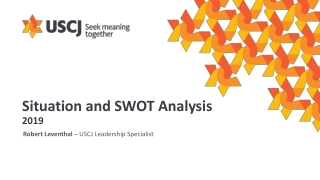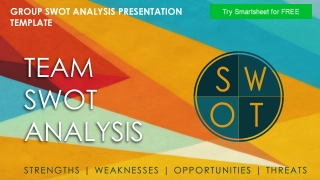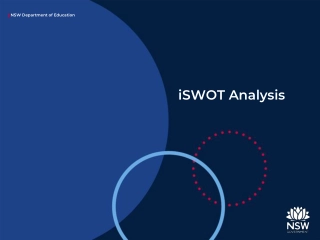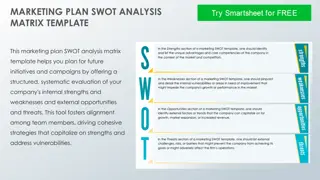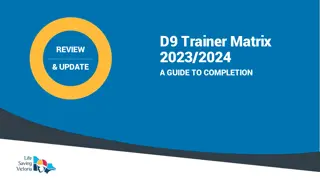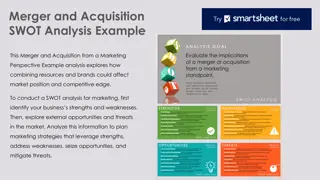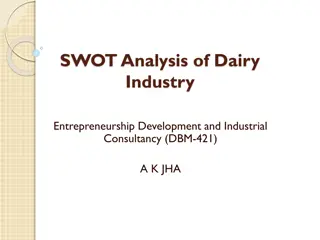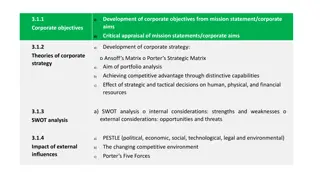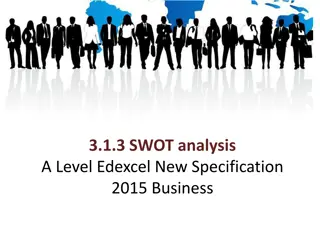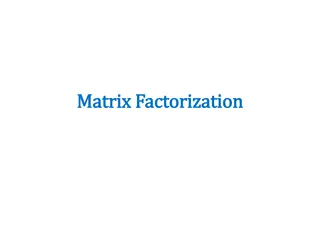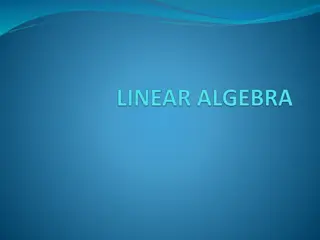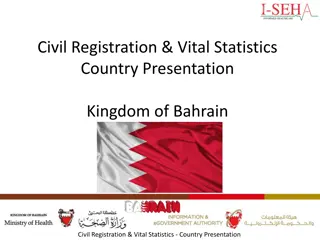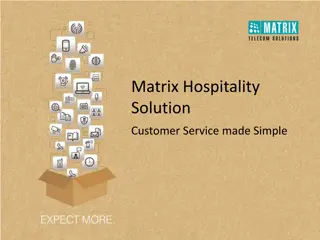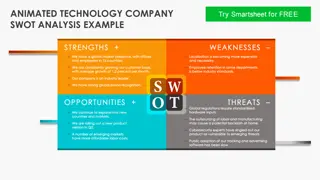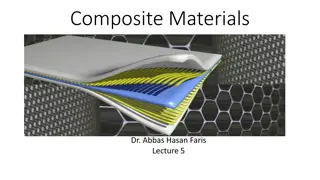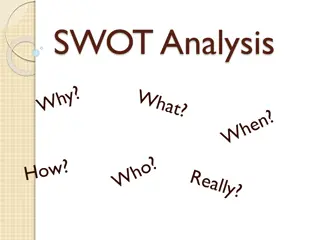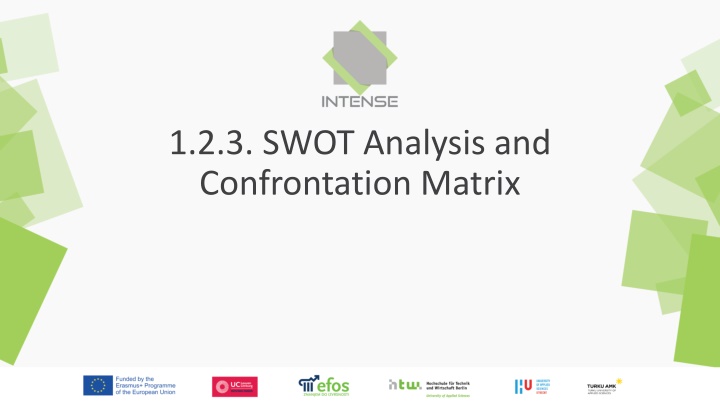
Developing International Strategies: SWOT Analysis and Confrontation Matrix
Learn the steps to develop international strategies, including SWOT analysis, external and internal analysis, strategy alternatives, and strategic implementation. Understand how to analyze the current business environment and utilize tools like PESTLE and confrontation matrix for effective decision-making.
Download Presentation

Please find below an Image/Link to download the presentation.
The content on the website is provided AS IS for your information and personal use only. It may not be sold, licensed, or shared on other websites without obtaining consent from the author. If you encounter any issues during the download, it is possible that the publisher has removed the file from their server.
You are allowed to download the files provided on this website for personal or commercial use, subject to the condition that they are used lawfully. All files are the property of their respective owners.
The content on the website is provided AS IS for your information and personal use only. It may not be sold, licensed, or shared on other websites without obtaining consent from the author.
E N D
Presentation Transcript
1.2.3. SWOT Analysis and Confrontation Matrix
Steps in Developing International Strategies 1. Mission and Objectives In previous modules 2. External Analysis 3. Internal and Competitive Analysis 4. Strategy Alternatives 5. Strategic Choice, Implementation, Feedback, and Control 2
Summarising Internal and External Analysis: SWOT Analysis 3
Learning Objectives Students are able to analyse the SWOT and develop strategies for the company by combining the strengths and weaknesses with the opportunities and strengths Students are able to recognise the advantages and limitations of using a SWOT analysis Students are able to connect a SWOT analysis to the internal and external analysis 4
Table of Contents Overview External and Internal Analysis (See C.1.2.1. and C.1.2.2) 1. SWOT Analysis 2.A EFA 2.B. IFA 3. Confrontation Analysis
Analysing the Current Situation Environment Suppliers Marketing Intermediaries Customers Competitors Publics Value Chain Company compared to competition Political/Legal Economic Social/Cultural Technological Ecological (Natural) Demographic Mind Map Meso environment Micro environment Macro environment Internal analysis External analysis Strengths & Weaknesses Opportunities & Threats 6
Macro Environment- PESTLE P E S T L E Political Economic Social Technology Legal Environment Economic Growth Emerging Technologies Stability of Government Income Distribution Taxation Laws Regulations and Restrictions Employment Rates IT Employment Regulations Changes to Legislation Demographics Infrastructure Inflation Rates Intellectual Property Consumer Attitudes Lifestyle Industry Regulations Global Influences Monetary Policy Culture Rights 7
Meso Environment Market/Industry Sector What is influencing the market and has an influence on how attractive a market is: Porter s 5 forces analysis Competitors Number of competitors Product/service Strategy Marketing efforts Consumers Demand One type of consumer or different types of consumers (segments) Product/service requirements Price sensitivity Promotion sensitivity Distribution requirements Alternatives that consumers have for this service (substitutes) 8
Meso Environment Market/Industry Sector What is influencing the market determines how attractive a market is Suppliers (they provide the resources to produce our goods/offer our service) How important are our suppliers to us? How easily can we cooperate with them? Intermediaries (resellers, wholesalers, distributors, retailers) Type of intermediaries Publics 9
Summary of the External Analysis The conclusion of this analysis is expressed in: Opportunities and Threats Essential: Macro environment cannot be influenced Meso environment: we have limited influence It s an expression of: Industry attractiveness (your own industry sector = meso environment) and Macro-environmental influences 11
RESOURCES tangible and intangible CAPABILITIES Internal Analysis 1. Brand, product, product life cycle 2. Market share (position in the BCG Matrix) 3. Value adding activities: Porter s Value Chain Technology People, talent/skills Location Intellectual property (patents) Marketing information/databases/research Partners 4. Financial position
Summary of the Internal Analysis The conclusion of this analysis is expressed in: Strengths and Weaknesses But always compared to your competitor (benchmarking) Essential: it can be influenced, you can change it yourself It s an expression of business assessment 13
SWOT Tips (1/2) For which market or country is the SWOT analysis? (might differ significantly per country or market) Make sure to have a SWOT with sufficient elements, try to have at least 5 aspects per S, W, O, T If possible use weights, prioritise Not all threats are equally negative Not all opportunities are to be followed by your company Some strengths can be more beneficial than others What are the most risky weaknesses? In order to be able to measure , compare your own company with competitors 15
SWOT Tips (2/2) Analyse how strengths can help you to use opportunities or to face threats Analyse which weaknesses hinder you to use opportunities A SWOT analysis is an analysis at a specific moment, should be updated regularly An opportunity can become a threat and vice versa Risks of oversimplification Risk of mix of relevant and irrelevant things (if not weighted) 16
Exercise: Is it S,W,O, or T for TESLA Europe Trends Macro, Meso or Micro S W O or T? Growing demand for electric cars Subvention on electric cars Big brand New technologies (that permit batteries to last longer) Other brands launch electric cars Train tickets get cheaper EU is increasing import tariffs from products from USA Exchange rate USD:EURO changing (USD is getting more expensive) Elon Musk is negative in the news 17
In-class Activity Strengths and Weaknesses Work in pairs and discuss your favourite bar or a restaurant (no chains) 1. Focus on what you like about the place and what can be improved What do you like about this place? What do you not like? What could the staff do to make it even more attractive? How could it make more profit but still be attractive to customers? What event organised by the company could cause the numbers of customers to go up? A local newspaper carries a report that the food in the caf /restaurant is expensive compared to other places Use the answers to formulate strengths and weaknesses for the company Marketingtools 1st year - Week3 TT2 - regular students
In-class Activity 2. How could the following events affect the business that you have described above? The rent of the bar/restaurant goes up Another caf /restaurant opens up on the same street Companies demand morning and afternoon snacks to be delivered to their offices The supplier of coffee, Illy, has difficulties with the delivery The local taxes in the community go up The exchange rate EUR:USD is changing; a higher value of the Euro (old: 1 euro = 1,17 dollar; new: 1 euro = 1,20 dollar), you pay your coffee in dollars Use the answers to formulate opportunities and threats Marketingtools 1st year - Week3 TT2 - regular students
2.a. Internal Factor Evaluation Matrix (IFE) Internal Factor Evaluation (IFE) Matrix is a strategy tool used to evaluate a firm s internal environment and to reveal its strengths as well as its weaknesses The IFE Matrix also provides a basis for identifying or evaluating relationships among those areas Can serve as input for a broader SWOT analysis
How to set up an IFE Matrix? 1.Take the key internal factors 2.Assign a weight that ranges from 0.0 (not important) to 1.0 (very important) to each factor 3.Assign a 1-to-4 rating to each factor to indicate whether that factor represents a major weakness (rating=1), a minor weakness (rating=2), a minor strength (rating=3) or a major strength (rating=4) 4.Multiply each factor s weight by its rating to determine a weighted score for each variable 5.Sum the weighted scores for each variable to determine the total weighted score for the organisation
2.b. External Factor Evaluation (EFE) Matrix External Factor Evaluation (EFE) Matrix is a strategy tool used to examine a company s external environment and to identify the available opportunities and threats EFE Matrix evaluates the external position of the organisation or its strategic intent Can serve as input for a broader SWOT analysis
External Factors (see previous session) Porter s Five Forces analysis (see previous session) or the Competitive Profile Matrix (see next slides) Economic Social Cultural Demographic Environmental Political Governmental Technological Competitive Legal
How to list an EFE Matrix? 1. List key external factors 2. Weight from 0.0 (not important) to 1.0 (very important) 3. Rate effectiveness of current strategies: 4= the response is superior, 3= the response is above average, 2= the response is average, 1= the response is poor 4. Multiply weight * rating 5. Sum weighted scores
3. Confrontation Matrix A Confrontation Matrix is a tool which is used to further analyse the output of a SWOT analysis It allows to analyse each different combination of strength, weakness, opportunity, and threat By doing this, the aim is to identify the most important strategic issues the organisation is facing
Questions to Ask/Answer How can you convert weaknesses to strengths? What do you have to do to use opportunities? How do you best neutralise threats?
How to build a Confrontation Matrix? Move across the matrix from left to right, starting with opportunity 1 (O1) Look at the different internal options (strengths and weaknesses) and assign a score of 3 to the best one, a score of 2 to the next best option, and a score of 1 to the next best option; all other options receive a score of 0 Continue working left to right across the matrix until you have completed the column for the final threat Alternative scoring mechanism is using + and symbols
How to build a Confrontation Matrix? From here, the next step is to investigate all of the combinations which have been identified as strategically important or interesting, and then continually narrow the various options down until the best strategy for the organisation remains
How to build a Confrontation Matrix? SO Strategies Use a firm s internal strengths to take advantage of external opportunities WO Strategies Aim at improving internal weaknesses by taking advantage of external opportunities ST Strategies Use a firm s strengths to avoid or reduce the impact of external threats WT Strategies Defensive tactics directed at reducing internal weakness and avoiding external threats 33
In-class Activity (continuing from slide 18) 3. Make a SWOT Matrix for your favourite bar or restaurant 4. Matching stage: formulate SO, WO, ST and WT strategies and or actions Marketingtools 1st year - Week3 TT2 - regular students
Homework Assignment SWOT Analysis (Assessment) Make teams: 3-5 people Choose one small or medium-sized enterprise per team, get the company approved by your lecturer and make sure you have access to information about the company Develop per team 4-5 slides: a SWOT matrix, including a SO strategy, a WO strategy, a ST strategy, and a WT strategy and split this into short-term and long- term strategies Try to compare the company with at least one competitor Give a minimum of 5 opportunities, 5 threats, 5 strengths, and 5 weaknesses Optional: give a 5-8 minute PPT presentation Important: add sources in your document
Summary Internal and external analysis can be summarised in a SWOT Internal Factor Evaluation (IFE) Matrix analyses a firm s weighted internal environment to reveal its strengths and weaknesses External Factor Evaluation (EFE) Matrix examines a firm s weighted external environment and to identify opportunities and threats A Confrontation Matrix is a tool which is used to further analyse the output of a SWOT analysis
Learning Objectives Students are able to analyse the SWOT and develop strategies for the company by combining the strengths and weaknesses with the opportunities and strengths Students are able to recognise the advantages and limitations of using a SWOT analysis Students are able to connect a SWOT analysis to the internal and external analysis 37
References Muilwik, E. (2009-2014). Meso Environment. Retrieved from https://www.intemarketing.org/marketing- information/marketing-environment/meso-environment Community Tool Box. (n.d.). Chapter 3. Assessing Community Needs and Resources | Section 14. SWOT Analysis: Strengths, Weaknesses, Opportunities, and Threats. Retrieved from https://ctb.ku.edu/en/table-of-contents/assessment/assessing- community-needs-and-resources/swot-analysis/main Employment, S. B. and T. (2011, July 28). Uses of SWOT analysis. Retrieved from https://www.business.qld.gov.au/starting- business/planning/market-customer-research/swot-analysis/uses Employment, S. B. and T. (2011, July 28). Benefits and limitations of SWOT analysis. Retrieved from https://www.business.qld.gov.au/starting-business/planning/market-customer-research/swot-analysis/benefits-limitations Employment, S. B. and T. (2011, July 28). Tips for a successful SWOT analysis. Retrieved from https://www.business.qld.gov.au/starting-business/planning/market-customer-research/swot-analysis/tips Employment, S. B. and T. (2011, March 8). Benchmarking your. Retrieved from https://www.business.qld.gov.au/starting- business/planning/market-customer-research/benchmarking 38

